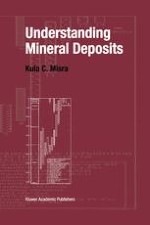2000 | OriginalPaper | Chapter
Sediment-Hosted Massive Zinc-Lead Sulfide (SMS) Deposits
Author : Kula C. Misra
Published in: Understanding Mineral Deposits
Publisher: Springer Netherlands
Included in: Professional Book Archive
Activate our intelligent search to find suitable subject content or patents.
Select sections of text to find matching patents with Artificial Intelligence. powered by
Select sections of text to find additional relevant content using AI-assisted search. powered by
This class of Zn-Pb sulfide (±barite±Ag±Cu) deposits constitutes a major global resource of zinc (>50%) and lead (>60%), and contributes 31% and 25%, respectively, of world’s primary production of zinc and lead (Tikkanen 1986). This deposit class has been variously referred to as: Sullivan-type massive sulfide deposits (Sawkins 1976a); subclasses of stratiform sulfides of marine and marine-volcanic association (Stanton 1972); exhalative sedimentary group (Hutchinson 1980); sediment-hosted submarine exhalative deposits (SEDEX) (Large 1980, 1981, Carne and Cathro 1982); sediment-hosted Pb-Zn deposits (Badham 1981); sedimentary-type stratiform ore deposits in flysch basins (Morganti 1981); sediment-hosted stratiform lead-zinc deposits (Lydon 1983); syngenetic and diagenetic lead-zinc deposits in shales and carbonates (Edwards & Atkinson 1986); and shale-hosted deposits of Pb, Zn, and Ba (Maynard 1991b). By analogy with the volcanic-associated massive sulfide (VMS) deposits discussed earlier (Ch. 10), the descriptive term sediment-hosted massive sulfide (SMS) deposits is preferred, because it emphasizes the lithologic association of the deposits and excludes any genetic constraint. Most of the deposits included here are dominantly stratiform (i.e., the deposits are composed of sulfide layers parallel to the bedding of the host sedimentary rocks), but some are not, particularly those that have been highly deformed (McClay 1983). In addition, many deposits either contain, or are associated with, mineralization that is not stratiform. As has been pointed out by Large (1983), the term massive sulfide, which loosely describes mineralization containing more than 50% sulfides, separates this class from other classes of sediment-hosted sulfide deposits, such as the sediment-hosted (stratiform) copper deposits (see Ch. 12) and the Mississippi Valley-type Pb-Zn deposits (see Ch. 13); there are also significant differences in the lithologic association, nature of mineralization, and metal ratios among these three classes of sediment-hosted deposits. Also excluded from the present discussion are sediment-hosted barite deposits without significant base metal enrichment, such as those of the barite districts in Arkansas and Nevada (USA), although both deposit types are regarded as exhalative in origin. In contrast to SMS deposits, which are hosted by basinal elastics in dominantly intracratonic rift settings, barite deposits display geochemical signatures that indicate the influence of oceanic crust and appear to have formed in compressional continental margin settings (Maynard 1991b), perhaps from cooler and shallower hydrothermal systems.
